Future Tubes
By Ron Rybs
@Ronrybs (20246)
London, England
September 20, 2016 7:27am CST
Future proofing is becoming a major feature of the design process for London trains.
On the left of the picture, above, is Clapham Common Station. When this station opened in 1900 it was the southern end of the Northern Line, until the line was further extended in the 1920s. This narrow 'island' platform, serving trains in either direction, was serviceable back then, but during rush hour today the island is packed; so much so I would not like to be standing near the edge as the trains run in.
On the right is Westminster Jubilee Line platform, serving trains in one direction only. This part of the station opened in 1999 and you can see the platform is about the same width as the island at Clapham. Additionally, there are platform edge doors, preventing people taking a tumble onto the tracks and they also control the rush of air created as trains approach the station. Still a busy place at rush hour, it is safer.
Since 1999 the Jubilee Line has already undergone one upgrade with an extra carriage added to every train to increase the number of people carried. This was planned for, but happened a few years earlier than originally thought.
7 people like this
7 responses


@BelleStarr (61355)
• United States
23 Sep 16
I guess eventually it won't be necessary to say "mind the gap" lol
1 person likes this

@BelleStarr (61355)
• United States
23 Sep 16
@Ronrybs My hubs wears a tee shirt that says Mind the Gap and no one here, knows what that means. We love it!!

@Tampa_girl7 (52185)
• United States
22 Sep 16
That's simply amazing that it was around in 1900.
1 person likes this
@teamfreak16 (43418)
• Denver, Colorado
20 Sep 16
That does look like it could get pretty hairy when packed.
1 person likes this













